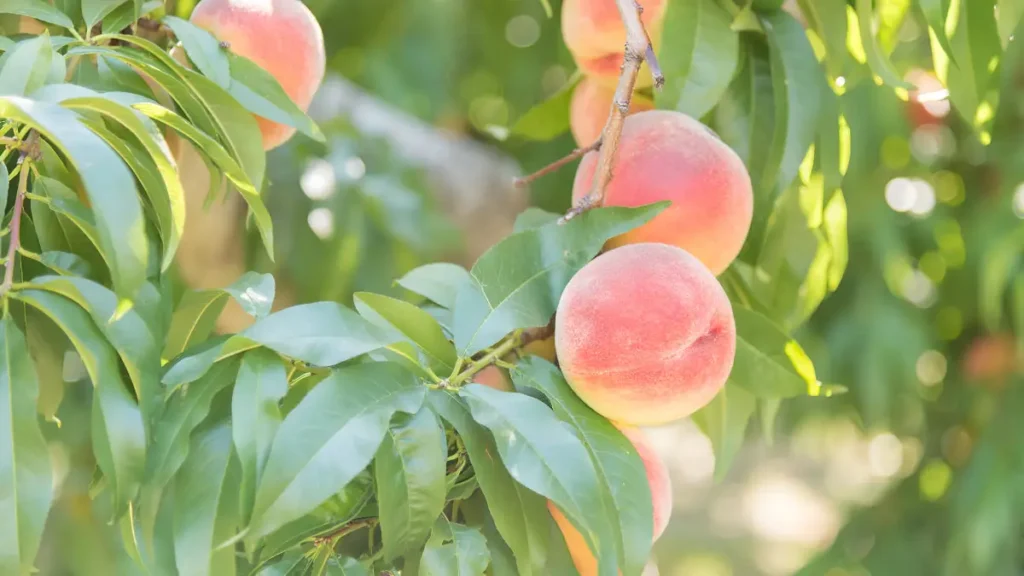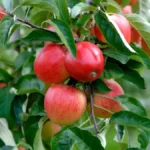Prunus persica, the peach tree, originating in Northwest China, is a deciduous tree that grows best in mild summers and cold winters. It is tiny to medium-sized, reaching 4 to 10 meters, and produces velvety-skinned peaches after pink blooms in spring. Peach trees are valued for their decorative beauty and cultural importance. Growing a peach tree in your garden can yield an abundant crop of sweet peaches each summer. In this post, we provide the best peach tree care advice to help you maintain a strong, fruitful tree.
Learn about how to grow a peach tree:
1. Selecting the proper variety of peach tree
Selecting the right peach variety is crucial for planting, as different cultivars suit different climates and soil types, with clingstone peaches ideal for canning and preservation.
- Climate Compatibility: Peaches thrive in mild summers and cold winters, so choose a variety with chill hours below 45°F for optimal dormancy and fruit production. Low-chill varieties like Flordaprince or Tropic Snow are ideal for mild winter regions.
- Soil Requirements: Peaches thrive in sandy loam, well-drained soil with a pH of 6.0 to 7.0. Test the soil and supplement it with organic matter if needed. Avoid thick clay soils, as they can cause root rot.
- Space Considerations: To flourish, peach trees require lots of area. Trees of standard size should be planted 15 to 20 feet apart, while dwarf kinds can be planted 10 to 12 feet apart.
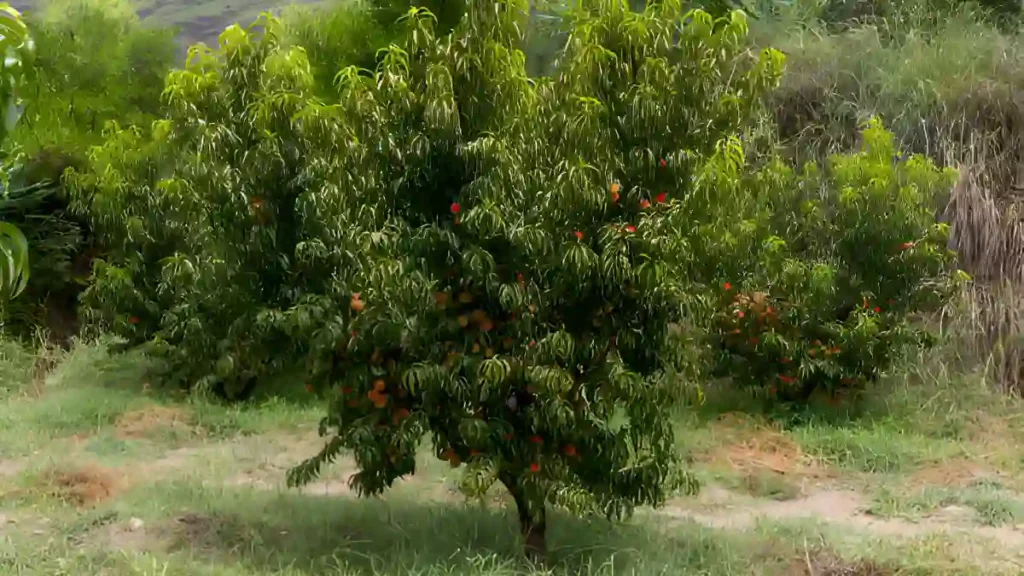
2. Planting the peach tree
Planting the right peach tree seedlings in early spring or late winter is crucial for its strong growth and healthy development.
- Planting Location: Planting peach trees requires a spot with 6-8 hours of direct sunlight daily, as sunlight generates energy for fruiting. Avoid low-lying areas with late frost buildup.
- Making the Hole: To ensure proper root growth and a solid base, create a hole twice as deep and wide as the tree’s root ball. To hydrate the roots, immerse them in water for a few hours before planting.
- Planting Depth: Plant the tree in a hole with level soil around the root collar to prevent root infections and ensure proper drainage.
- Backfilling and Watering: Backfill the hole with excavated dirt, compact it, and water the tree after planting. Allow the soil to settle around the roots, and add a 3-inch layer of mulch to prevent rot.
Peach tree care:
1. Watering and graining
Your peach tree needs regular watering to be healthy, especially in the early years while the tree is establishing its root system.
- Watering Schedule: Watering a peach tree requires a specific schedule, varying based on climate and rainfall. Regular watering during dry spells is crucial to prevent root rot and maintain moist soil.
- Techniques of Irrigation: Soaker hoses or drip irrigation are ideal for peach trees as they directly hydrate roots without soaking leaves, preventing brown rot and peach leaf curl.
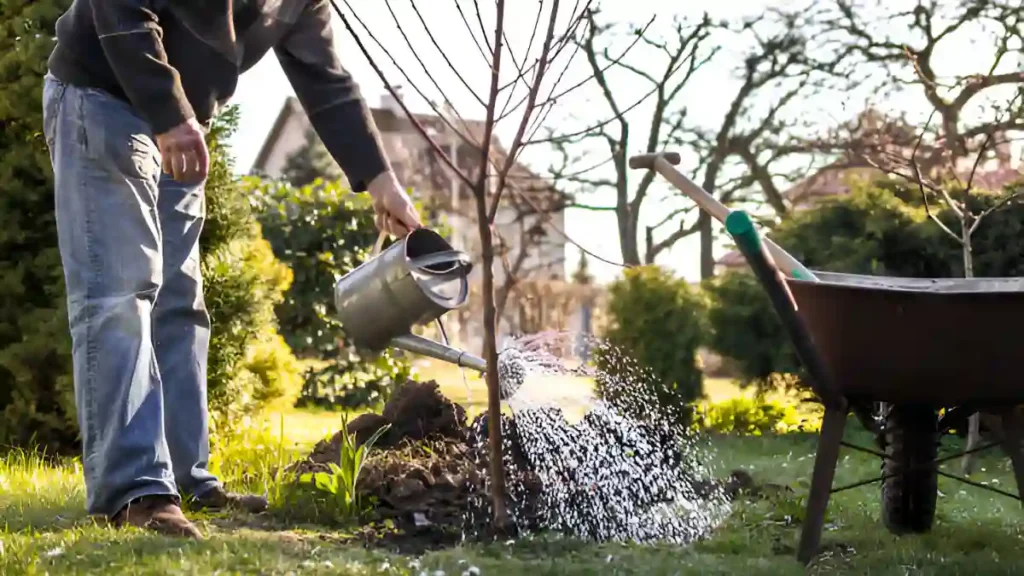
2. How to prune a peach tree for optimal growth
Pruning is crucial for peach tree care, promoting healthy growth, air circulation, and fruit yield. Open-center pruning is optimal for allowing sunlight into the canopy.
- Pruning Schedule: The optimal time for pruning a peach tree is late winter or early spring, with summer pruning being another option to reduce overgrowth and increase light penetration.
- How to Prune a Peach Tree: Remove dead or damaged limbs, trim back branches to create an open vase shape, lower illness risk, and improve fruit quality. Reduce tree height to 10-12 feet for manual fruit harvesting.
- Fruit Thinning: To ensure fruit size and prevent branch fracturing, thin peaches manually and space them 6-8 inches apart on branches. Pruning also prevents branches from fracturing due to excessive fruit.
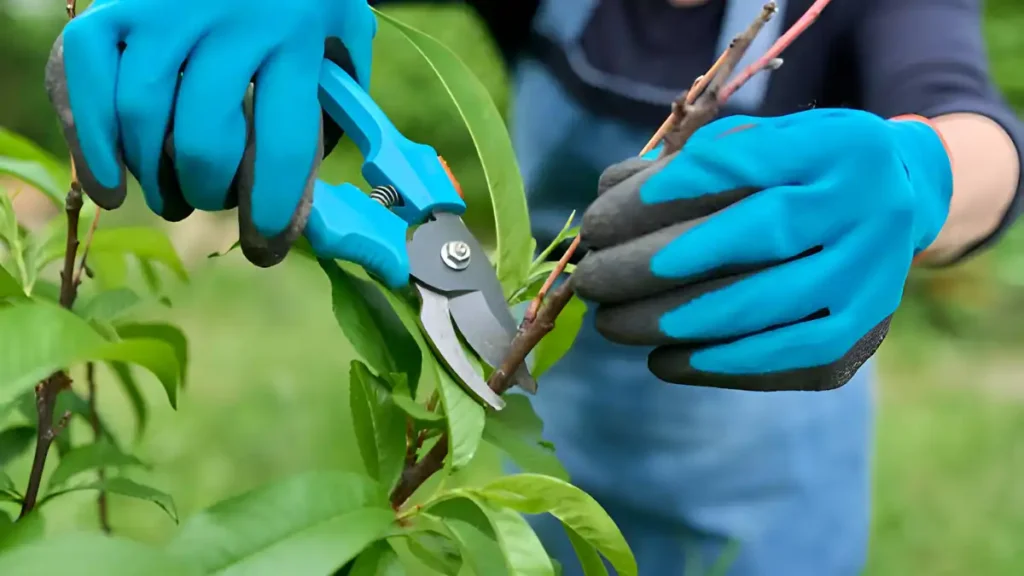
3. How to fertilize a peach tree
Proper fertilization is crucial for fruit health and abundance, ensuring a balanced supply of micronutrients like iron, zinc, magnesium, nitrogen, phosphorus, and potassium.
- When to Fertilize: Fertilize your tree in early spring, using a balanced 10-10-10 blend, according to the package’s rate, but avoid overfertilization, as excessive fertilization may result in too many leaves instead of more fruit.
- Fertilizers: Organic fertilizers like fish emulsion, compost, or well-rotted manure can be used as natural alternatives to fertilize plants, gradually releasing nutrients into the soil for consistent growth and fruiting.
4. Control of peach tree diseases
Peach plants are prone to several pests and illnesses. Being proactive in handling any issues is essential to maintaining the health and productivity of your tree.
- Common pests causing harm to peach plants include scale insects, aphids, and peach tree borers. Regularly check for infestation symptoms and treat with horticultural oil or insecticidal soap.
- Fungal Diseases: Brown rot, powdery mildew, and peach leaf curl are common fungi damaging peach trees. Regular pruning, removing diseased branches, and using a fungicide spray in spring can help prevent these issues.
Conclusion:
To grow and care for a peach tree, choose a sunny spot with well-drained soil, plant in early spring, water frequently, especially in dry spells, and cover the soil with mulch. Adherence to comprehensive maintenance guidelines can result in a healthy tree yielding an abundant crop.
Certainly! If you’d like to learn more, please consider following our WhatsApp Channel: Harvest Gardening
A frequently asked questions:
Q1: Will a peach tree grow in the UK?
A1: Peach trees in the UK, particularly in warmer southern regions, may thrive but may require protection against frost and chilly breezes during spring blooms.
Q2: When to harvest peaches?
A2: Peaches are typically harvested in mid to late summer when they have a rich, uniform color, slight give when pressed, and a sweet perfume.
Q3: Can peach trees grow in India?
A3: Peach trees thrive in milder climates in northern India, such as Himachal Pradesh, Jammu & Kashmir, and Uttarakhand, due to their cooling hours.
Q4: Can you grow a peach tree from a cutting?
A4: A peach tree can be grown from a softwood cutting, but requires close tending and is most effective in warm, humid conditions with a well-drained medium.

